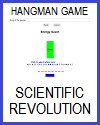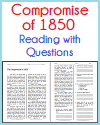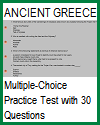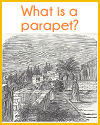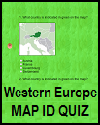Gettysburg to Appomattox |
Yet none of the Confederate victories was
decisive. The Union simply mustered new armies and tried again.
Believing that the North's crushing defeat at Chancellorsville
gave him his chance, Lee struck northward into Pennsylvania at
the beginning of July 1863, almost reaching the state capital at
Harrisburg. A strong Union force intercepted him at Gettysburg,
where, in a titanic three-day battle—the largest of the Civil
War—the Confederates made a valiant effort to break the Union
lines. They failed, and on July 4 Lee's army, after crippling
losses, retreated behind the Potomac. |
1. What is the capital city of
Pennsylvania? a. Allentown b. Gettysburg c. Harrisburg d. Philadelphia |
2. The largest battle of the Civil War was
fought where? |
More than 3,000 Union soldiers and almost
4,000 Confederates died at Gettysburg; wounded and missing
totaled more than 20,000 on each side. On November 19, 1863,
Lincoln dedicated a new national cemetery there with perhaps the
most famous address in U.S. history. He concluded his brief
remarks with these words: |
... we here highly resolve that these
dead shall not have died in vain – that this nation, under God,
shall have a new birth of freedom – and that government of the
people, by the people, for the people, shall not perish from the
earth. |
3. When did Lincoln deliver the Gettysburg
Address? |
On the Mississippi, Union control had been
blocked at Vicksburg, where the Confederates had strongly
fortified themselves on bluffs too high for naval attack. In
early 1863 Grant began to move below and around Vicksburg,
subjecting it to a six-week siege. On July 4, he captured the
town, together with the strongest Confederate Army in the West.
The river was now entirely in Union hands. The Confederacy was
broken in two, and it became almost impossible to bring supplies
from Texas and Arkansas. |
4. What town was captured by Ulysses S.
Grant on July 4, 1863? |
The Northern victories at Vicksburg and
Gettysburg in July 1863 marked the turning point of the war,
although the bloodshed continued unabated for more than a
year-and-a-half. |
5. What two battles, fought in July of
1863, were the turning point of the U.S. Civil War? |
Lincoln brought Grant east and made him
commander-in-chief of all Union forces. In May 1864 Grant
advanced deep into Virginia and met Lee's Confederate Army in
the three-day Battle of the Wilderness. Losses on both sides
were heavy, but unlike other Union commanders, Grant refused to
retreat. Instead, he attempted to outflank Lee, stretching the
Confederate lines and pounding away with artillery and infantry
attacks. "I propose to fight it out along this line if it takes
all summer," the Union commander said at Spotsylvania, during
five days of bloody trench warfare that characterized fighting
on the eastern front for almost a year. |
6. Who was made commanding General of the
U.S. Army in 1864? |
7. What type of warfare characterized
fighting on the eastern front in 1864? |
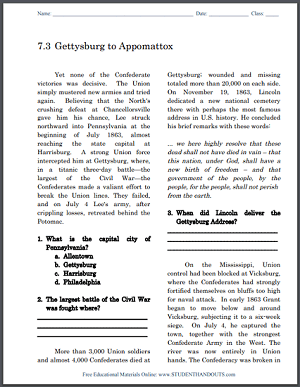 In the West, Union forces gained control of
Tennessee in the fall of 1863 with victories at Chattanooga and
nearby Lookout Mountain, opening the way for General William T.
Sherman to invade Georgia. Sherman outmaneuvered several smaller
Confederate armies, occupied the state capital of Atlanta, then
marched to the Atlantic coast, systematically destroying
railroads, factories, warehouses, and other facilities in his
path. His men, cut off from their normal supply lines, ravaged
the countryside for food. From the coast, Sherman marched
northward; by February 1865, he had taken Charleston, South
Carolina, where the first shots of the Civil War had been fired.
Sherman, more than any other Union general, understood that
destroying the will and morale of the South was as important as
defeating its armies. In the West, Union forces gained control of
Tennessee in the fall of 1863 with victories at Chattanooga and
nearby Lookout Mountain, opening the way for General William T.
Sherman to invade Georgia. Sherman outmaneuvered several smaller
Confederate armies, occupied the state capital of Atlanta, then
marched to the Atlantic coast, systematically destroying
railroads, factories, warehouses, and other facilities in his
path. His men, cut off from their normal supply lines, ravaged
the countryside for food. From the coast, Sherman marched
northward; by February 1865, he had taken Charleston, South
Carolina, where the first shots of the Civil War had been fired.
Sherman, more than any other Union general, understood that
destroying the will and morale of the South was as important as
defeating its armies.8. Infamously, General Sherman systematically destroyed railroads, factories, warehouses, and other facilities in his path while marching his troops through what Confederate state? a. Alabama b. Georgia c. Mississippi d. Texas |
9. Why did Sherman use a scorched earth
military strategy? |
Grant, meanwhile, lay siege to Petersburg,
Virginia, for nine months, before Lee, in March 1865, knew that
he had to abandon both Petersburg and the Confederate capital of
Richmond in an attempt to retreat south. But it was too late. On
April 9, 1865, surrounded by huge Union armies, Lee surrendered
to Grant at Appomattox Courthouse. Although scattered fighting
continued elsewhere for several months, the Civil War was over. |
10. Where and when did General Lee
surrender to General Grant? |
The terms of surrender at Appomattox were
magnanimous, and on his return from his meeting with Lee, Grant
quieted the noisy demonstrations of his soldiers by reminding
them: "The rebels are our countrymen again." The war for
Southern independence had become the "lost cause," whose hero,
Robert E. Lee, had won wide admiration through the brilliance of
his leadership and his greatness in defeat. |
11. magnanimous: a. closed-minded b. considerate c. petty d. stingy |
12. To this day, Robert E. Lee is a
respected military leader. Is this praise justified? Why or
why not? |
Answer Key: 1. C - Harrisburg 2. Gettysburg, Pennsylvania 3. November 19, 1863 4. Vicksburg 5. Vicksburg and Gettysburg 6. Ulysses S. Grant 7. Trench warfare 8. B - Georgia 9. He understood that destroying the will and morale of the South was as important as defeating its armies, and didn't want to leave the South with anything it could use to stage a counterattack 10. Appomattox Courthouse on April 9, 1865 11. B - considerate 12. Answers will vary. Click here to print this worksheet. |
 |
|---|
Text courtesy of the U.S. State Department,
Bureau of International Information Programs, 2005 |


